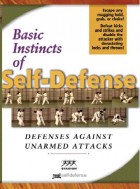Pros and cons of two opposing approaches to teaching and learning defenses against attacks
There are two approaches to learning self-defense skills.
One approach starts with students practicing predetermined defenses, each against a known attack, for example, a left block against a right punch. With considerable practice, students eventually learn to anticipate the form of attack correctly and may respond instinctively with the most appropriate technique.
This first approach leads to spectacular results but requires many thousands of repetitions of defenses to learn it properly. Students who practice with partners who have considerable ring- or street-fighting experience will learn (consciously or subconsciously) the subtle moves that precede each type of attack. Eventually, thanks to picking up on those clues, the students may anticipate the attacks and instinctively defend with the appropriate move. The drawback of this approach is that it takes those thousands of repetitions to learn to respond to each different type of attack. It also requires that the training partner be intimately familiar with the technique of the attack — otherwise the student will learn wrong clues.
The other approach starts with students practicing one type of defense against a whole variety of similar attacks, for example, entry into a clinch against all fist strikes. In this “instant” approach the student is taught what attacks can be made at a given distance, what their common weak spots are, and how to neutralize a whole class of attacks with one and the same move. For example, at a distance greater than one length of your attacker’s leg, you are not likely to be unexpectedly grabbed or hit with a fist, knee, elbow, or headbutt. To hurt you, the attacker must either reduce the distance or do a full extension kick which could reach you because of the rotation of the attacker’s body. In such a kick, from this distance, the attacker has to aim for your midsection. (He or she would have to be closer to kick your knees or head.) Knowing this you do not have to anticipate where the kick is going and since all kicks at full extension can be defeated with the same move, you don’t have to anticipate the type of kick either. In the case of hand strikes, this approach relies on jamming an attacker’s arms, because at an arm’s distance you can lay your hands on your attacker’s hands and then either enter into a clinch or throw your own punch or kick. (This is a simplification. To see how these defenses work, see Basic Instincts of Self-Defense.)
In the second, instant approach, because it does not rely on correct anticipation of a specific form of attack, the partner’s skill is not so critical. The number of repetitions needed to learn the universal defenses is much smaller — intelligent and fit people master them in a course of at most a few workouts. Those who keep practicing these techniques against skilled partners will develop the ability to anticipate correctly too, and eventually will be able to use specific defenses against various attacks.
To learn more techniques, see Basic Instincts of Self-Defense.
Next, Self-Defense Tip #14 — Selecting a Self-Defense System, Part I.
Self-defense tip from Thomas Kurz, co-author of Basic Instincts of Self-Defense and author of Science of Sports Training, Stretching Scientifically, and Flexibility Express.
Self-Defense Moves
For your defense moves to work under stress they must be based on your natural, instinctive reactions, require little strength and limited range of motion, and be proven in fighting experience.To learn how your natural reactions can instantly defeat any unarmed attack, see the video Basic Instincts of Self-Defense.
Defend Against Weapons
To defend against weapons you have to know how they are used. Also — every stick has two ends … the weapon of attack may become a weapon of defense in your hand …To learn how the typical street weapons (club, knife, razor) are used by an experienced streetfighter and how to practice with them, see the video Self-Defense: Tools of Attack — Club, Hatchet, Blackjack, Knife, Straight Razor.
Mental Toughness
Staying cool under pressure is more important for self-defense than being physically fit and technically skilled. If you can’t control your mind what can you control?To learn mental techniques that let you calmly face any threat and act rationally in the heat of a fight, click here.
For a complete list of our products, click here.








This post is actually a lot more thoughtful and important than perhaps even the author realizes; as it touches the least discussed aspect of self-defence/fighting: reaction.
The approach no.1, while common, has several other drawbacks (other than long training time etc):
-the predictive capabilities (predicting the attack from preceding cues) of the mind tend to worsen or crumble under emotional pressure; ie exactly what happens in self-defence
-among the more attacks (and defenses) you have to distinguish, the slower the response is. Thus, for example, person who knows 4 different blocks responds a lot slower than one who only knows one.
-if the opponent uses attack you are not trained to recognize, you fail to respond